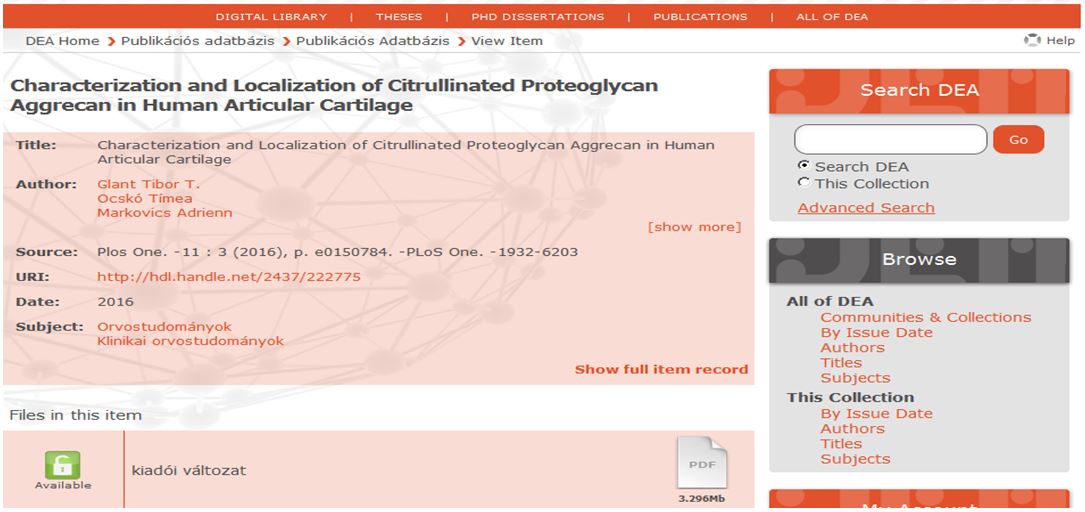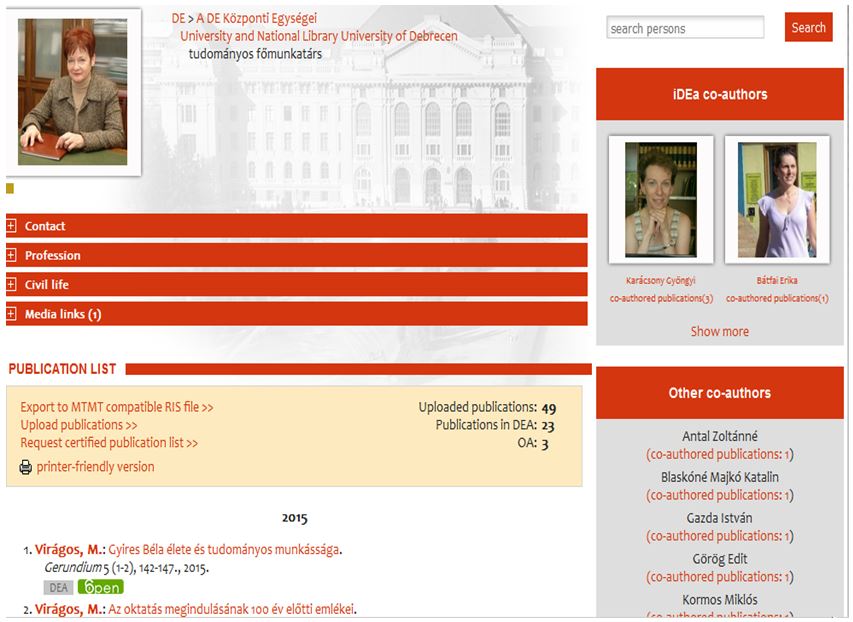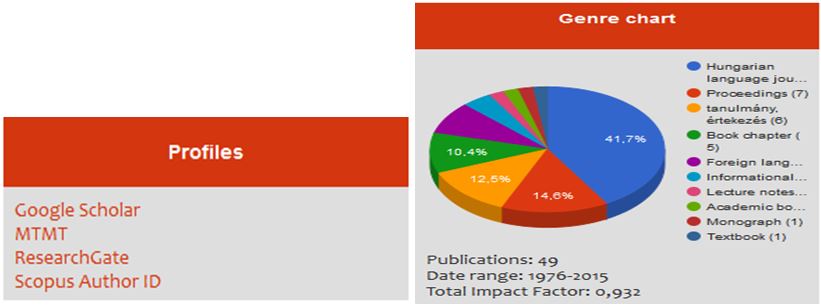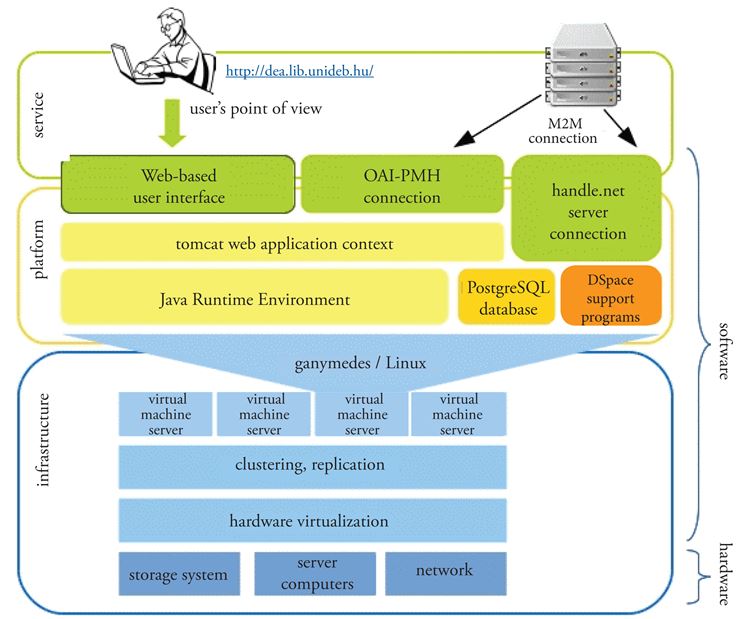University and National Library, University of Debrecen
Hungary
mviragos@lib.unideb.hu
Abstract
A growing number of universities is beginning to require the digital deposit of their thesis and dissertation output in their institutional repositories (IR). At the same time, a growing number of universities as well as research funders are beginning to mandate that all refereed research must be deposited too. In general, the benefits include preservation and dissemination of scholarly communication, increased and continous access of free and affordable information. The University Library of Debrecen was the first among higher education libraries in Hungary to establish (in 2007) and manage an institutional repository (DEA) with value added services.
Objectives:
In this paper we describe the DEA and iDEA project, the implementation of an integrated scientific portal of the University of Debrecen. Issues discussed include the core functions, as well the development, implementation, reception and the main benefits of the portal.
Methodology:
For the design of the new portal, an analysis of the existing sotware (Dspace) was executed, shortcomings and improvement requirements were identified, and comerison to scholarly federated search engines (Google Scolar, Research Gate) was made.
Keywords:
research communication, institutional repository, knowledge management, research visibility
Introduction:
The networked world has had a profound impact on research and communication practice over the past decade, and practices continue to change. The last decade has also seen sharp growth in levels of research activity, and a related growth of interest in monitoring and assessing research performance. Open access to peer reviewed journal articles is one of the main goals of the international movement that is changing the paradigm of scholarly communication (1,2,3).
Visibility has also become a key issue in funders’ requirements in the past decades. In most cases funders require that the research results, financed by them, should be demonstrated to all shareholders in an open and transparent manner. Such requirements are met usually not only by implementing the visibility and branding policies of the given funder, but also by providing open access to the research results(4,5).
Libraries are critically important in helping researchers to exploit the full benefits and opportunities of the networked world, including such developments as open access and scientific social networks. Libraries’ expertise in information management and in scholarly communications, and their position allows them to help the academic world to exploit the full benefits and opportunities of a digital networked world by, for example:
- promoting new models of dissemination and publication;
- developing institutional repositories (IR) to collect, preserve and disseminate research outputs;
- offering advice on copyright issues.
It has been stated many times in the literature that faculty members don’t self-archive in institutional repositories without library mediation (6,7,8). Ferreira, Rodrigues, Baptista and Saraiva (9) describe efforts at the University of Minho to increase the number of faculty articles deposited to their IR including promotional efforts, value-added services and the development of a mandate.
While most of today’s discussion about OA concentrates on the cost and sustainability of the system and on the choice between gold and green roads, other interesting issues emerge, including the viability and benefits of OA in the medium and long term . OA contributes to an ecosystem where research publications are free to access and linked to each other, and subject to multiple evaluative methods and criteria (e.g. open peer review and webometrics) (10,11.).
The European OA policy
Three developments mark the progress towards making OA the general principle for EU funded research. The first was in December 2007 when the European Research Council (ERC) published the open access guidelines for peer-reviewed publications for ERC-funded research projects. Then in 2008, the European Commission began a pilot that required researchers funded under the Seventh Framework Programme for Research an Technological Development. Thirdly in December 2010, the OpenAIRE infrastructure was launched to realise the widespead adoption of these open access policies.
Open Access in Hungary
In Hungary most of the universities have now repositories to store and make institutional assets available such as research papers, research documentation, theses and digital collections. University libraries with the Library of the National Academy of Science are involved in supporting Open Acces, in 2008 they signed a Consortium Agreement and founded HUNOR (HUNgarian Open Access Repositories). The members of HUNOR are dedicated to promote international know-how and standards, to organize and maintain a methodology centre and disseminate best practices of repository development.
The University of Debrecen (UD) is a public higher education institution, founded in 1912, has become an intellectual center in Hungary. The University, with its student body of 30,000, 14 faculties, and academic staff of 1500 and non-academic staff of about 5000, does everything in its power to serve the role of one of the most prestigious universities of the country. The University of Debrecen offers the widest scale of Ph.D. programmes in the country. Research groups work with academics, researchers, students and entrepreneur communities within and also outside the University of Debrecen. The research capability and reputation is greatly enhanced by strong international presence of our esearch networks, and the early adaptation of Open Access guidelines on an institutional level. The institution was the second signer of the Berlin Declaration in 2009 and the first adapter of an institutional repository mandate.
The University and National Library of the Univerity of Debrecen (DEENK) has been a central unit of the university with 7 units situated on 5 different university campuses. The current holdings of DEENK exceed six million library items. Owing to its national and regional responsabilities, the University Library receives copyright issues and maintains the National Document Delivery System (ODR) of Hungary and coordinates the HUNOR association. The University and National Library of Debrecen has been actively involed in open access initiatives both on national and international levels (EUROPEANA Travel, EUROPEANA Cloud, PEER-Project, OpenAIRE, OpenAIRE Plus). The library functions as OpenAIRE national open access desk (NOAD), and It also hosts the Open Access national website (www.open-access.hu). The University Library of Debrecen was the first among higher education libraries in Hungary to establish and manage an institutional repository (DEA). Besides receiving and archiving scientific literature, the repository plays a significant role in the promotion of self-archiving and open access publishing.
Repository Project
Phase one
In 2007 the library put forward a 5 year proposal to develop an institutional repository. In this project the concept of IR was defined as a set of services for storing and making digital research materials available based on the digital collections of the library. In 2012 a second project was launched funded by an EU grant. The aim was to develop a scientific portal, a virtual space where the creation and transfer of knowledge is supported and enhanced according to the global standards of scholarly communication.
The main strategic goals of Debrecen University Electronic Archive (DEA) are the following:
- to create one storehouse of the institute’s various cultural, research and educational materials, which offers services to research communities and students both within and outside the university;
- to play a crucial role in the scientific and scholarly communication by means of promoting of self-archiving and open-access publishing;
- to maximize the uptake, usage and impact of the university research input at all stages and to provide new and poweful indicators for professional qualification to the university management.
For the design of DEA the aim was to create thematic collections of digital objects built on the administrative structure of the university and reuse existing bibliographic descriptions. The library integrated catalogue (CORVINA) system was used not only for cataloguing, acquisition, loan and administration, but in a separate archive, a Publication Database had been developed. Academics can manually upload details of their publications which are then corrected and transferred to the Library OPAC by librarians.
Concerning the sotware platform, there are several options available for IRs including Eprints, Fedora, DSpace, and Digital Commons. For our goals the DSpace sotware was the most suitable. DSpace is an open-source repository software platform developed jointly by Massachusetts Institute of Technology (MIT) Libraries and Hewlett-Packard. DSpace can handle multiple item formats, including text, audio, image, and video. One of its distinguishing features is its ingest process, wich allows delegated users to submit their own materials to the repository.
DEA like most DSpace installations, is organized into communities and collections that tend to correspond to research and academic units of the univesity.
Collections of DEA
- Digital library composed by e-books, digitized books, digitized periodicals, maps and photos (28 374 items). Most of the documents are library holdings digitized for cultural and archival purpose.
- Theses: both under-graduate and master students have to submit an electronic copy of their thesis to the repository. Students are submitting their own ETDs after their Education Department certifies them as eligible with additional metadata elements such as the name of the student’s advisor and the copy right declaration (33 266 items).
- PhD Dissertation: according to the Hungarian Higher Education Law doctoral dissertations should be made avaiable open-access on the web. PhD students are obliged to upload their dissertation before the defence. In case of trade secret an embargo function will enable student to restrict access to the dissertation for a set of period. In the workflow doctoral school administrators check the eligibility and made them available (2666 items).
- Publications (4000 items available open access): one of the important results of the project is that the library’s separate publication database was integrated into the DEA containing all types of research outputs created by the university researchers such as project papers, pre-and post print version of articles, book chapters, etc.
The repository offers basic and advanced search options for users, and browsing possibility for different metadata fields. The system displays a short description of the item (title, author(s)), date of the deposit, URI, and the availability of the full text).

Process of deposit
For undergraduate and graduate students the workflow is the same, they have to fill the deposit form, attach the copyright declaration and send the document for upload. The validation process could vary by faculties: in some cases the education office, in other cases the librarian approves the submission. The deposit workflow used to be the same for researchers, however since the integration of the publication database to the new portal, they have to upload their data through a new upload platform.
Phase two: Developing value added services
Perheps the most crucial value of institutional repositories lies in the added value of services through which it can support the interest of the local community. The Information portal of the University iDEA (www.idea.unideb.hu) presents a state of the art medium for researchers, teachers and students to search and disseminate scholarly results. The iDEA portlal system embodies the main aspects of knowledge management. It creates a forum to exchange information on scholarly work within the institution. Researchers can have an easy access to their publication list, and furthermore, they can get a picture about other scholars’ work and research associations. The portal also offers information about the results of research fields an subjects and about academics working within them-
The portal (www.idea.unideb.hu) consists of four separate, but interlinked parts which cover various aspects of academic life.

- Science (Tudomány) : the site provides an opportunity for the researchers and units of the institution to enhance the visibility of their research outputs. It also offers up to date statistics about the institution’s academic activities and creates a new forum for information dissemination. Besides the actual news from the scientific life of the University and the Hungarian scientific community , one can get information about articles with the highest impact factor.
- Talents (Tehetség): is a continously updated online scientific and social forum for the future generations of researchers. The site gives up-to- date information about the latest doctoral dissertations and masters’ theses. It offers assistance for doctoral students and members of Students Associations in providing easy access to the most important information for their research such as Open Access, refererence softwers, linked data, how to cite.
- Tradition (tradíció): offers a review of the institution’s research past: a virtual exhibition assembling information about the lives and work of former Rectors and distinguished researchers and showcasing paintings, sculpters and other art pieces related to them.
The mos innovative part of the iDEa portal, the Research Profiles (http://tudoster.idea.unideb.hu/)
present the academic activities and the professional profiles of the institution’s researchers.The easy-to-use and functional site offers various up-to-date tools providing effective help for university members and the outside world. The primary goals of the Research Profiles are introducing the works and results of research units and creating an electronic calling card for our researchers which provides a comprehensive picture about the researchers’ scholarly and teaching activities and their off-campus lives. Researchers can create a direct link to other research networks (Google Scholar, Research Gate).
Personal profile
The menu of the profile database allows search in and browsing through the profiles of researchers and academic units (departments, institutions, faculties) of the university.

The primary goals of the Research Profiles are:
- offering easy access to the scientist’s publication list and where it possible to get the full-text,
- creating an electronic calling card for our scientists which provides a comprehensive portfolio about the researchers’scholarly and teaching activities and their off-campus lives,
- introducing the research projects and their outputs of the university units,
- browsing among the research fields and subjects and identifying the researchers connected to them,
- developing a social forum for scientists enhancing the cooperation among various disciplines,
- bringing the professionals closer to the business world, and
- improving the cooperation between science and society.
The elements of the profile are the following:
Personal data: photo, affiliation information with link to the units profile, contact information, personal information and media materials.
Publication list: the full publication list is displayed by type and year of publication. Authors can upload the record and the full text of their articles and ask for a certified publication list.
Statistical data: profile of co-authors with a link to their profile and to co-written articles, publications by documents type (pie chart with links), publications by year (coloumn chart with links), publications by journals.
An important feature of the profile that author could set up direct links to other scolarly profile like Google Scholar, ResearchGate, Linkedin, MTMT)


Similar to the researchers’s profiles, the unit profile contains the publication results of the department/institution and statistical look at the unit’s scientific output. Links are also provided here to the profiles of the individual researchers.
The university can also utilize these Profiles to showcase the institution’s assets and knowledge bank. The impact of the researchers’ work is demonstrated through the statistical charts the profiles offer based on the publication and citation information. The increasing number of titles in the researchers’ publication list opened up to access freely through the Reserach Profiles may also indicate the institution’s active participation in the open access movement.
Technical overview
Architecture: The iDEa web services are hosted in the Library’s private cloud. The hardware system consists of multiple components, it contains SAN based storage units, enterprise-level backbone network devices and server computers. Web applications are running in PHP running environment and Java application container.
Applications are developed on multiple platforms. The Research Profile (RP) website is a Drupal site, therefore modules has been developed in PHP. Other technologies used by this site are: HTML, CSS, JavaScript/JQuery, XML, XSL, RSS
The data that appears on RP comes from various sources. Most of the data is provided by Java web services (Axis2, SOAP), and some through RSS channels. The Java web services request data from the integrated library system Corvina database (Oracle), the Publication database (Postgresql), the Education Administrative System (Neptun), and the University LDAP. The web services pass the requested data to the Drupal site that is responsible for displaying it.
There are two Java web services: one is responsible for retrieving data from the Corvina database, the other for retrieving data from the Publication database, Neptun, and the University LDAP.
The Publication database contains data about the university researchers and units (name, profession, email etc.) It is a Postgresql database, the version number is 8.4, it is hosted on Debian 6. The data can be retrieved and modified through one of the web services.
The other web service is responsible for gathering data from the Corvina database. This database contains metadata about publications. It is an Oracle database, but data is not stored in accordance with the relational schema, it is stored in a format that is very similar to MARC (Extensible Data Management Architecture). The web service gathers MARC records from the database, processes them to retrieve the necessary data, and produces xml files that are cached for faster access. The generated xml files are updated daily.

Conclusion:
Perhaps the most crucial value of institutional repositoriums lies in the added value of services in which it can support the interests of the local community. Researchers and educators using the data base keep providing feed-back pertaining to the services provided. Owing to the local connection, the incoming remarks, observations about deficiencies, recommendations, lists of faulty operation can be responded to promptly by the repository management or specialists responsible for maintenance and operation. In the light of incoming demands and needs, as well on the basis of the professional area of the institute, the international scientific and financial expectations, the purpose of the development is the objectification of services which facilitate the application of the repository and which internationally render the content of the data base valuable and accessible.
References:
- Harnad, S., & Brody, T. (2004). Comparing the inpact of open access (OA) vs.non-OA articles int he same jounals. D-Lib Magazine. 2004; 10(6).
- Nielsen M. Reinventing Discovery: The New Era of Networked Science, Princeton, N.J.,Princeton University Press; 2011.
- Koler-Povh, T.,Mikos, M. and Turk, Z. Institutional repository as an important part of scholarly communication. Library Hi Tech. 2014; 32 (3);423-434.
- Lynch, C.A. Institutional repositories: Essential infrastructure for Scholarship int he Digiral Age. Portal: Libraries and the Academy. 2003.3.(2);327-336.
- Asunka,S., Chae, HS. and Natriello, G. Towards an understanding of the use of an institutional repository with integrated social networking tools: a case study of pocket knowledge. Library Information Science Research, 2011; Vol. 33.(1), 80-88.
- Kim, J. Faculty self-archiving: Motivation and barriers. Journal of the Americal Society for Information Science and Technology. 2010; 61 (9), 1909-1922. http://dx.doi.org/10.1002/asi.21336.
- Cullen, R. and Chawner, B. Institutional Repositories, Open Access, and Scholarly Communication: A Study of Conflicting Paradigms. The Jounal of Academic Librarianship. 2011; 37 (6) 460-470.
- Foster, N.F. and Gibbons, S. Understanding Faculty to Improve Content Recruitment for Instituional repositories. 2005; D-Lib Magazine. 11 (Jan).
- Ferreras-Fernandez, T., Garcia-Penalvo, F.J., Marlo-Vega, J.A. Open Access repositories as channel of publication scientific grey literature. ACM 978-1-4503-3442-6/15. DOI: http://dx.doi.org/10.1145/2808580.2808643.
- Scholze, F. Measuring research Impact in an Open Access Environment. Liber Quarterly. 2007. 17 (3/4); http://liber.library.uu.nl (April 2016)
- Cullen, R. and Chawner, B. Institutional Repositories: Assessing their Value to the Academic Community. Performance Measurement and Metrics. 2010. 11. (2); 131-147.

